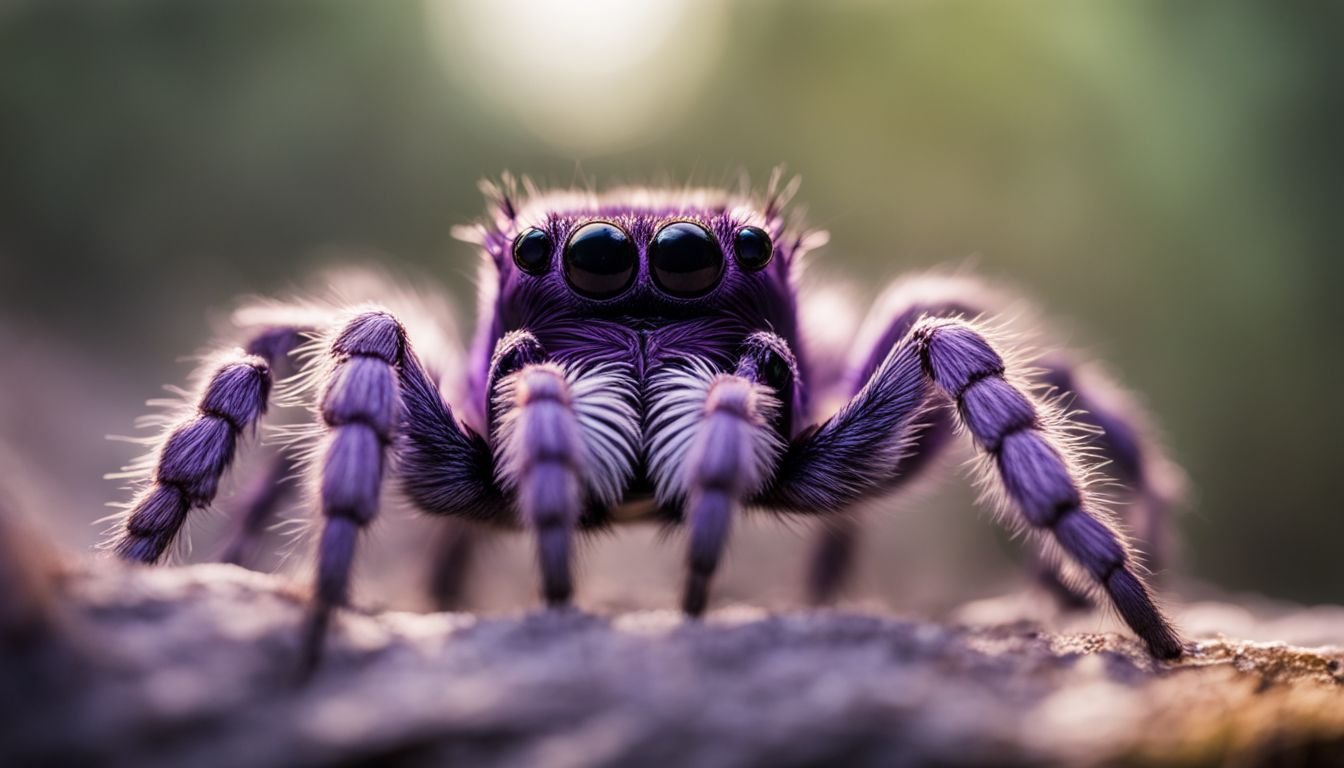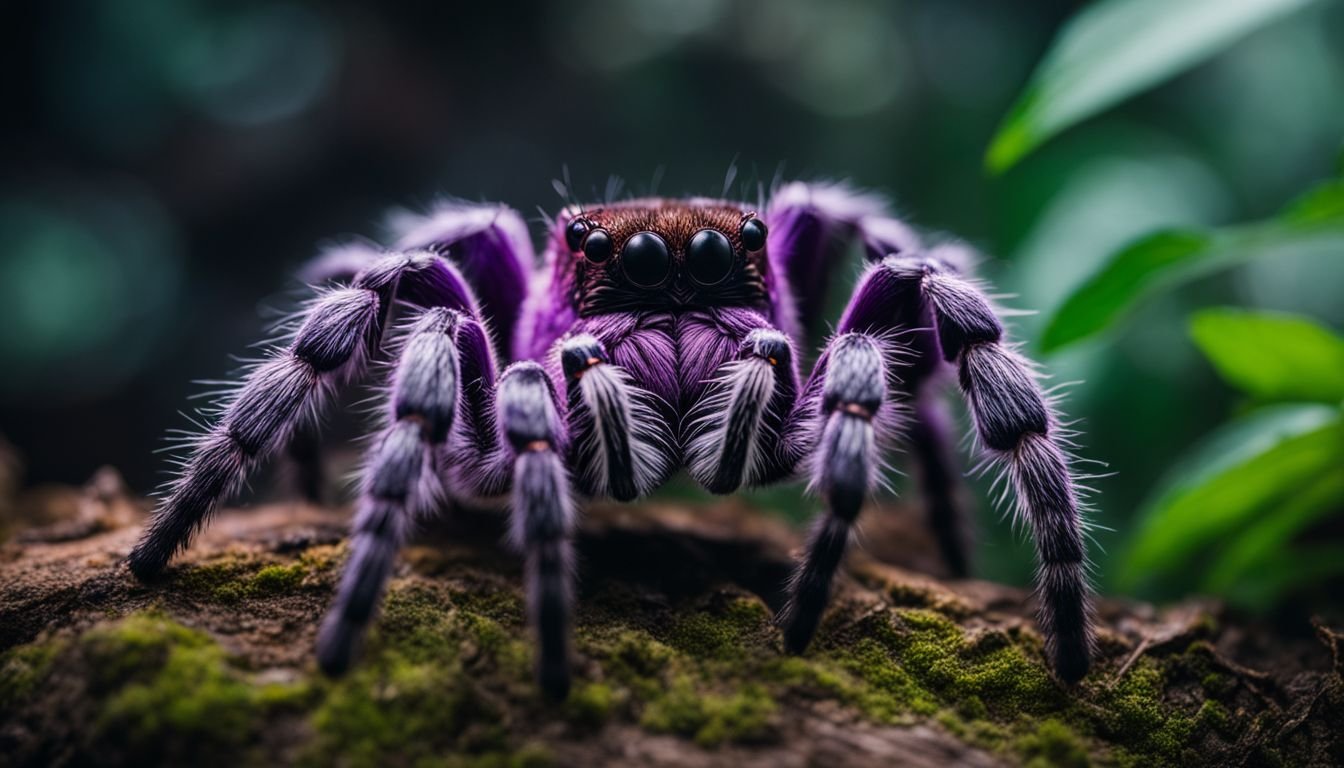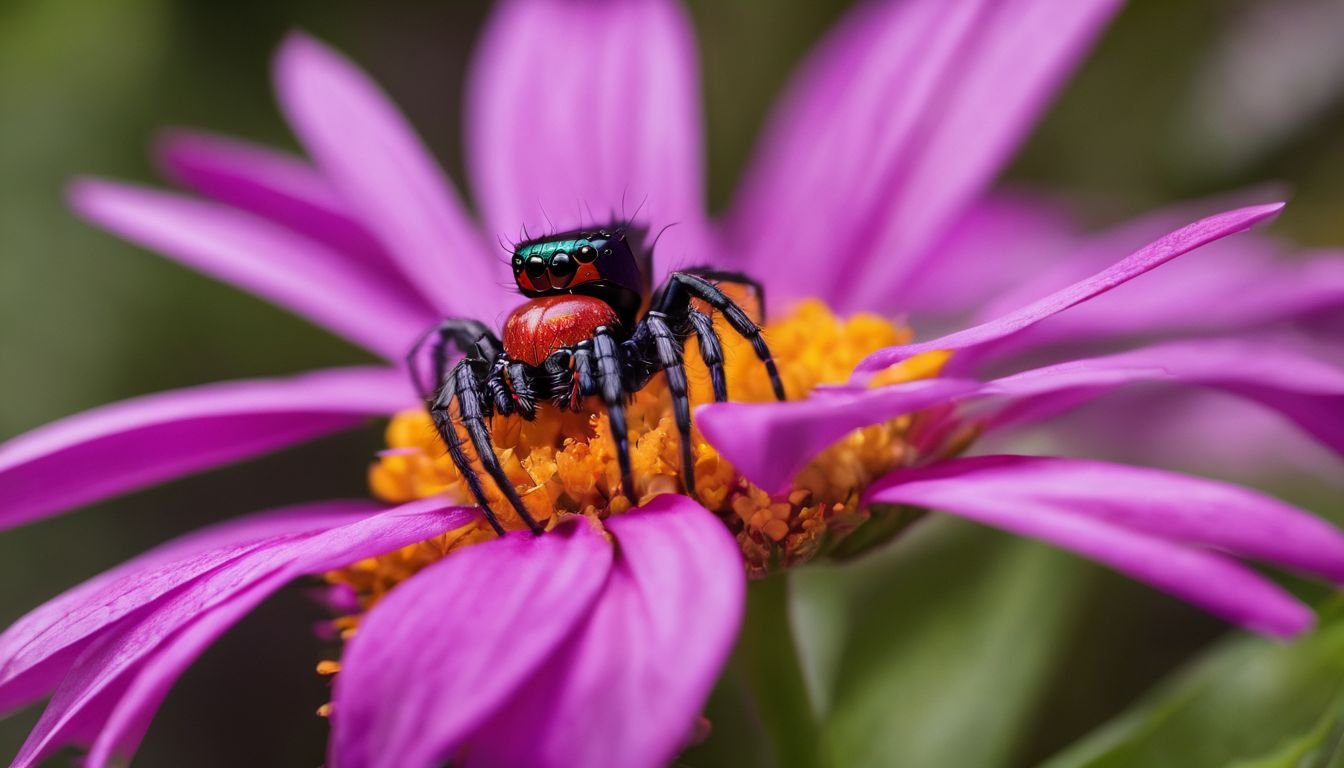Australia’s wildlife is nothing short of spectacular, and when you start talking about our spiders, well, you’re in for a real treat – or fright, depending on how you look at it! Purple spiders are the talk of the town with their striking colours that could easily make them contenders for “Australia’s Next Top Model” in the spider world.
But hold your horses; despite all the yarns spun around these critters, there’s plenty of hogwash out there.
So we took a fair dinkum crack at setting the record straight. Because let’s face it: who hasn’t been snagged by curiosity about these vibrant arachnids? Yet before we get too ahead of ourselves thinking purple spiders are as Aussie as Vegemite on toast, turns out the Avicularia purpurea actually calls Ecuador home.
Blimey, right? But that doesn’t dim our enthusiasm one bit; if anything, it shows just how wide-reaching our fascination with unique creepy crawlies can be.
Our blog’s set to sort fact from fiction and give you a squiz at what makes these lil’ beauties tick – from their life cycle and where they prefer to hang their hats (or webs), to what gets their tummies rumbling and how we can lend a hand in keeping them around for generations to come.
Buckle up for an enlightening dive into the colourful world of purple spiders. You’re sure to find some ripper stories waiting for you!
Key Takeaways
- Purple tarantulas, scientifically named Avicularia purpurea, mainly dwell in the lush forests of Australia and are known for their striking purple-blue iridescence.
- These spiders have a diet consisting mostly of crickets, cockroaches, mealworms, waxworms, darkling beetles, and occasionally small rodents. Their prey choices reflect their adaptability as hunters in various environments.
- Female purple tarantulas can lay up to 120 eggs at once. After six to eight weeks, between 50 to 120 nymphs hatch from these eggs, showcasing the species’ impressive reproductive strategy geared towards survival.
- Despite being formidable predators with urticating hairs for defense against threats like wasps and birds, they face numerous predators themselves including larger insects and small mammals.
- The conservation status of these spiders remains largely unknown due to limited research within Australia. This highlights the need for more study on how they fit into local ecosystems and any potential threats they may face.
Overview of the Purple Tarantula

We’ll dive straight into the fascinating world of the Ecuadorian Purple Tarantula, a remarkable member of the Theraphosidae family. This spider charms with its vibrant hue and intricate behaviour patterns that intrigue scientists and enthusiasts alike.
Scientific Classification
As Australians who cherish our diverse plant and garden life, we find the intricate connections between our flora and the native animals endlessly fascinating. Among these, the purple tarantula, known scientifically as Avicularia purpurea, presents a unique instance of the rich biodiversity our land supports. Described in 1990 by P.J. Kirk, this species underlines the marvels hidden within our ecosystems. Here’s a quick glance at its scientific classification, providing insights into its place within the web of life.
| Scientific Classification of Avicularia purpurea | |
|---|---|
| Kingdom | Animalia |
| Phylum | Arthropoda |
| Class | Arachnida |
| Order | Araneae |
| Family | Theraphosidae |
| Genus | Avicularia |
| Species | A. purpurea |
Delving into the scientific classification of the purple tarantula gives us precious insights into its evolutionary history and how it fits into our broader ecological community. This knowledge not only enriches our understanding but also deepens our appreciation for the intricate balance of life that thrives in our Australian gardens and beyond. It reminds us of the responsibility we carry in preserving this diversity for future generations to marvel at and learn from.
Physical Characteristics
Female spiders of this species boast a remarkable size, growing up to 13 centimetres in length. They captivate with their distinct purple-blue iridescence, which adorns their dorsal surface, legs, palps, and chelicerae.
This unique colouration not only sets them apart in the natural world but also intrigues those of us passionate about Australia’s diverse flora and fauna.
They’re equipped with urticating hairs, a defence mechanism that can deter predators such as wasps. These hairs cause irritation when they come into contact with the skin or mucous membranes of potential threats.
It’s fascinating how these spiders use what nature has given them to protect themselves from tarantula hawks and other dangers lurking in their environment.
Their physical adaptations serve as a testament to the resilience and complexity of life in our Australian landscapes. We marvel at how creatures like the purple spider find ways to thrive, shedding light on the intricate connections between all living beings and our natural world.
Behavior
We’ve found that the Purple Tree Tarantula has quite the intriguing lifestyle, predominantly making its home in tree hollows. These arboreal spiders showcase their engineering skills by crafting elaborate nests where they can live and hunt.
They’re not just hanging around in trees for fun; these spaces provide them with a strategic advantage to catch their prey, which includes insects and small rodents. Their habitat choice reflects their adaptability and skill in navigating complex environments.
Their reproductive habits are equally fascinating. Laying up to 120 eggs in a single go shows how prolific they can be. From these eggs hatch anywhere between 50 to 120 nymphs after six to eight weeks, showcasing an impressive survival strategy.
It’s a clear demonstration of how nature ensures the continuation of species through numbers, giving each nymph a fighting chance at life amidst the hazards of predators and environmental challenges.
Habitat and Distribution of the Purple Tarantula

We discover these remarkable purple tarantulas predominantly in the dense, lush forests of Australia. They carve out their domains amidst thick undergrowth and deep soil crevices, thriving in environments that offer both shelter and abundance.
Native Locations
We’ve uncovered some fascinating data about the native locations of the purple spider species, Avicularia purpurea. These awe-inspiring creatures predominantly make their homes in a range of unique environments.
- Amazon Region of Ecuador: This spider thrives in the lush, dense rainforests found here, where the humidity and temperature provide an ideal habitat. The diverse plant life offers abundant hiding spots and hunting grounds for these spiders.
- Agricultural Areas: Surprisingly, purple spiders have adapted to life in agricultural zones. They find refuge among crops and vegetation, which also attract a variety of insects for them to prey on.
- Urban Settings: Another unexpected fact is their presence in urban areas, particularly in spaces below roofs or within holes in buildings. This adaptation showcases their ability to thrive in a variety of environments, despite human encroachment on their natural habitats.
Preferred Habitats
After exploring the native locations of the purple tarantula, we now delve into their preferred habitats to better understand where these fascinating creatures thrive. The Purple Tree Tarantula, known scientifically as Avicularia purpurea, shows a strong preference for living in trees.
They find safety and comfort in the hollows of trees where they can build their nests away from predators. This arboreal lifestyle is essential for their survival and well-being.
These spiders also adapt to changes in their natural environments by making homes in less traditional places. They have been found nesting in agricultural areas and even taking advantage of human-made structures by residing in the holes of buildings or spaces below roofs.
Such flexibility shows how resilient and adaptable purple tarantulas are to different environments.
Gardeners and plant lovers might be intrigued to know that creating gardens with plenty of tree cover could make their green spaces more inviting for species like the Purple Tree Tarantula.
Although not everyone’s cup of tea, understanding how these creatures select habitats helps us appreciate the biodiversity within Australian landscapes, including our own backyards.
Conservation Status and Threats
We’re diving deep into the world of the purple tarantula, uncovering its struggle against predators and environmental challenges. Its conservation status raises alarms about the urgent need for protective measures to ensure these unique spiders continue to thrive in Australia’s diverse ecosystem.
Predators
Australia hosts a remarkable array of wildlife, including the stunning purple tarantula. Its vibrant colour doesn’t just attract the eye of humans; it also draws in various predators that pose a threat to its survival.
Current Conservation Status
We face a significant challenge in understanding the conservation status of the purple spider species here. This creature, primarily found in the vast Amazon region of Ecuador, remains shrouded in mystery within Australia’s borders due to scant research and documentation efforts.
Our knowledge gaps make it difficult to grasp fully or address any threats that this exotic tarantula faces on our soil.
Conservation efforts specifically targeting this spider are virtually non-existent locally, posing a risk not only to its survival but potentially affecting native ecosystems as well.
It’s crucial for us enthusiasts who cherish our natural world to advocate for more extensive studies and protection measures for these elusive creatures. Perhaps through increased awareness and scientific inquiry, we can better understand how they fit into our ecological tapestry.
Let’s turn our attention now towards their diet and reproduction habits, another fascinating aspect of their existence that sheds light on their role in nature’s complex web.
Diet and Reproduction of the Purple Tarantula
The purple tarantula has a distinct diet, primarily feasting on insects like flies, which it captures with remarkable precision. Its reproduction process showcases the fascinating cycle of life these creatures go through, ensuring their species continues to thrive in Australia’s unique ecosystem.
Prey Preferences
We often wonder what fuels the mysterious purple tarantulas in our Australian backyards. Their diet showcases the fascinating interplay between predator and prey in our natural ecosystem. Here’s a closer look at what these vibrant spiders feast on:
- Crickets: Crickets top the menu for our eight-legged friends. These insects are abundant and easy for purple tarantulas to catch, making them a staple food source.
- Cockroaches: Another favorite, cockroaches provide essential nutrients. These creatures, often found lurking around our gardens, become prime targets for hungry spiders.
- Mealworms: Rich in protein, mealworms offer a nutritious snack. They help keep our spider population healthy and active.
- Waxworms: Soft and easy to digest, waxworms are like a treat for these arachnids. They’re especially beneficial for younger spiders needing extra energy to grow.
- Darkling Beetles: These beetles contribute variety to the spiders’ diet. Their harder shells present a fun challenge for purple tarantulas to overcome.
- Small Rodents: Occasionally, Avicularia purpurea might snag a small rodent. This is less common but highlights their adaptability and prowess as hunters.
Reproduction Process
We’ve learned that the female purple tarantula plays a pivotal role in the species’ survival by laying up to 120 eggs in a single cocoon. Imagine our gardens teeming with life as, six to eight weeks later, anywhere from 50 to 120 nymphs hatch and begin their journey into adulthood.
This remarkable reproductive capacity ensures that even amidst challenges, the purple tarantula thrives.
Turning our focus now towards how these spiders interact with their surroundings, especially plants and the natural environment, we discover an intricate web of connections far beyond what meets the eye.
Plants and Natural Environment Interactions (Link: https://gardenplantjoy. com. au/blogs/plants)
Our gardens and local ecosystems often benefit from understanding the complex relationships between plants and their natural surroundings. This knowledge can significantly impact how we approach gardening, emphasising the importance of creating environments that support both our beloved plants and native wildlife.
The Purple Tree Tarantula, Avicularia purpurea, showcases a fascinating interaction with its environment that garden enthusiasts should appreciate. These spiders use plant leaves to create shelters for protection against predators and harsh weather conditions.
Their presence in gardens can indicate a balanced ecosystem where various species coexist harmoniously.
Incorporating native plants into our gardens attracts beneficial insects which, in turn, provides food for predators like the Purple Tree Tarantula. Such interactions highlight the delicate balance within natural ecosystems and remind us of our role in maintaining this equilibrium.
Choosing plants wisely not only beautifies our spaces but also supports local fauna, including these unique tarantulas. Encouraging such biodiversity ensures healthier gardens by promoting natural pest control methods and contributing to ecological stability.
Understanding these interactions further enriches our gardening practices, making them more sustainable and environmentally friendly. We learn to value the interconnectedness between flora and fauna, recognising each plant we select has an impact beyond mere aesthetics or personal satisfaction.
Adopting strategies that enhance these natural relationships fosters a thriving garden ecosystem where diverse life forms flourish together.
Conclusion
We’ve journeyed through the incredible world of Australia’s purple spider species. These astonishing creatures dazzle with their purple-blue iridescence, showcasing nature’s artistry.
Their ability to adapt and thrive in diverse habitats highlights their resilience. Whether nestled in tree hollows or finding refuge in urban spaces, they play a crucial role in our ecosystems.
Let’s cherish and protect these fascinating beings for future generations to marvel at.
FAQs
1. What makes the purple spider species in Australia unique?
The purple spider species stands out due to its vibrant color and rarity in Australian nature. Unlike the common spiders, these possess a distinctive purple hue that sets them apart.
2. Can purple spiders fly?
No, purple spiders cannot fly. Despite their impressive agility and ability to jump between locations swiftly, they lack the physical attributes necessary for flight.
3. Where can I find purple spiders in Australia?
Purple spiders are typically found in specific habitats across Australia, including forests and regions with dense vegetation where they can hunt and build webs undisturbed.
4. Are purple spider bites dangerous to humans?
Generally, bites from a purple spider are not considered dangerous to humans. Their venom isn’t potent enough to cause serious harm; however, it’s always wise to exercise caution around any wildlife.
